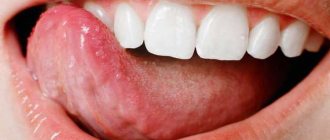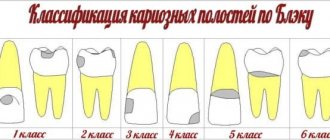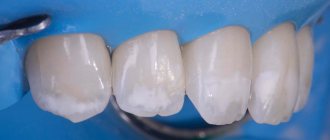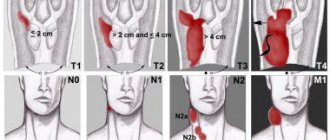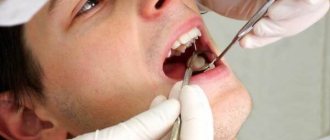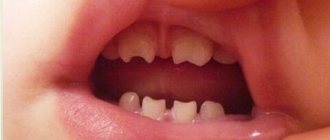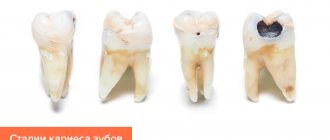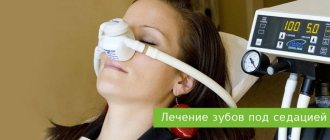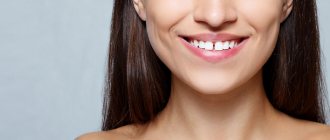Many people suffer from incorrect and aesthetically unattractive position of teeth in the mouth. There are cases called prognathia and retrognathia, which are different from protrusion and retrusion. In this option, the position of all the teeth is correct, but the row itself grows inward or protrudes outward.
But cases with a small number of isolated units or a small cluster are already a pathology. If the teeth protrude and move forward, the patient suffers from protrusion. When the opposite situation is visible, and part of the row falls inward, the teeth are called retrusive.
Protrusion of teeth is
This anomaly is difficult to miss, even for a person without medical education.
Protrusion means protrusion. In medical science, this word refers to conditions in which certain anatomical parts protrude beyond their natural position. For example, this is a protrusion of an intervertebral disc or a protrusion of teeth. In the latter case, the front teeth are tilted too forward. They seem to stick out from the jaw. Dental protrusion is not only a cosmetic problem (although the aesthetic component is quite significant), but also a general medical one. In this case, the teeth are susceptible to injury, they quickly wear out and become damaged. Therefore, tooth protrusion requires adequate treatment. In most cases, this is the domain of orthodontics. Special orthodontic products (in particular, braces) will help correct the abnormal position of teeth. In some cases, it is necessary to resort to surgical correction.
Symptoms of protrusion
The protrusion may not manifest itself for a long time, but over time a person may still experience pain because the disc puts pressure on the nerve roots. The spinal cord may also be damaged if it becomes compressed, which can also lead to pain and various diseases of the internal organs.
Protrusion may not manifest itself for a long time, but, despite this, develop
It is good if lumbar protrusion is detected at a very early stage - thanks to this, complications in the form of a hernia can be avoided. Despite the fact that it can be “hidden”, its presence can still be identified: both through diagnosis and with the help of certain symptoms.
Signs of protrusion
The following signs are characteristic of protrusion of anterior teeth:
- the front teeth appear too large because they are tilted forward;
- the teeth are fanned out to the sides, causing large gaps to form between them;
- too tight or parted lips;
- speech defects (lisp, spattering of saliva).
Symptoms of an open bite
An open bite is defined by a number of facial, intraoral and functional features.
Symptoms on the face
- lengthening the lower part of the face;
- persistent facial expressions, such as surprise, which are more common in people with a long facial area;
- mouth open;
- protruding tongue between the lips and holes between the jaws;
- short and inactive lower lip;
- smoothing the chin and nasolabial folds;
- asymmetry in jaw size.
Intraoral symptoms
The main intraoral symptom of an open bite is the lack of closure of the anterior or lateral teeth and the presence of perforations between them. If the bite is not congenital, but acquired, the crack takes the shape of an object that the child is used to sucking: fingers, nipple, toys, feathers and much more. Other distinctive features are also highlighted:
- General asymmetrical appearance and disproportionate width of the maxillary arches and palate;
- close proximity of incisors and canines;
- ribbed shape of the cutting edge of the front teeth;
- complete or partial absence of hard tissues of dental units;
- extensive caries diseases;
- a large amount of deposits on the teeth in the form of plaque and tartar;
- painful enlargement of gingival papillae - redness, bleeding, growth.
Functional symptoms
Functional disorders in open bite have the greatest impact on the quality of life of patients. Between them:
- dysfunction of biting and cutting food: chewing efficiency is 8-37% lower than normal in patients of different ages;
- swallowing disorder, such as newborn or infant swallowing;
- dry mouth due to its constant state of openness;
- deep damage to periodontal tissues;
- disruption of the temporomandibular joints;
- diseases associated with the gastrointestinal tract, which leads to disruption of primary food processing;
- speech problems associated with difficulty speaking with lips, wheezing and labial sounds;
- oral breathing.
Causes
The causes of this anomaly differ depending on the age at which it appeared. If tooth protrusion has already developed in the primary occlusion, then the reasons may be:
- hereditary factors;
- intrauterine development disorders;
- early introduction of complementary foods (excessive load on the jaws);
- bad childhood habits (thumb sucking, excessive use of pacifiers).
If a defect is formed in a mixed bite, then the following reasons are considered:
- crowding of teeth due to excessively large front incisors (noted with underdevelopment of the upper jaw);
- bad habits;
- tongue size is too large;
- mouth breathing;
- late loss of baby teeth.
In permanent dentition (in adults), tooth protrusion usually occurs against the background of periodontal disease. The following factors contribute to this:
- pathological receding gums;
- exposure of the neck of the tooth;
- loosening of teeth (due to which they can take a different position).
Symptoms and diagnosis
Protruding 2 front teeth are usually visible to the naked eye. If you look at a photo of a patient’s teeth with this anomaly, you will notice a noticeably deformed bite. The severity of symptoms depends on the strength of the changes.
- If the front teeth protrude forward, the patient develops speech defects.
- When pathology develops in a child, learning difficulties arise.
- If a tooth in the upper jaw protrudes, difficulties arise in closing the mouth.
- With excessive protrusion, the upper gum protrudes so that at rest the mouth remains open by 4 mm or more.
- If teeth grow incorrectly, complexes appear. It is especially difficult to get rid of them if the problem appeared in childhood.
Types of protrusion
A protrusive bite can form on one of the jaws, or on both jaws at once (bimaxillary protrusion). Let's consider the features of such options.
Bimaxillary protrusion
In this case, the abnormal position of the teeth is noted on the upper and lower jaws. This is a fairly rare variant of the pathology. In the vast majority of cases, people with this anomaly are unable to fully close their lips.
Upper jaw
In this case, only protrusion of the upper incisors is observed. This variant of the anomaly is characterized by shortening of the upper lip and underdevelopment of the facial muscles. Due to anatomical features, such patients often have a slightly open mouth.
Lower jaw
Protrusion of the lower jaw, as a rule, develops due to bad habits or congenital underdevelopment of the lower jaw. For this reason, teeth lack space and protrude forward.
Features of protrusion
A tooth or several move forward as they grow for a reason; there must be reasons for this, and there are. This pathology can occur when there is not enough space in the mouth for a tooth, associated with underdevelopment of the jaw, an excess number of teeth or the large size of neighboring units. Another reason is the incorrect formation of primordia during the early removal of milk.
Another reason is the late change of rows to permanent ones. Protrusion can also occur due to pathological habits such as thumb sucking, open mouth breathing or gnawing on foreign objects. The result of all these reasons are: tremor, crowding, large sizes of the frontal units and the pathology itself.
The vestibular position, as the process of moving teeth forward is also called, has three types. The first option involves pathology of two jaws at once. The second and third options, respectively, separately for the upper and separately for the lower incisors.
Diagnosis of the disease
Diagnosis of such a defect is not considered difficult. A doctor can make a diagnosis only by external examination of the oral cavity. In addition, the specialist will pay attention to indirect signs, such as mouth breathing or chronic diseases of the respiratory tract.
If tooth protrusion is suspected, the patient is subject to the following types of examinations:
- dental examination;
- patient interview;
- radiography;
- additional research methods (at the discretion of the doctor).
Consequences for humans
Some people do not attach much importance to dental defects. Aesthetics don't bother them. But in the case of protrusion, different consequences for the body are observed. Doctors believe that excessively inclined incisors increases the risk of damage.
The anomaly leads to severe crowding of the teeth or the appearance of large gaps. All this does not add beauty to the smile. In the area of the dental arch, elongation is observed in the anterior part, and this leads to deformation of the jaw.
Any malocclusion distorts speech. There is discomfort in eating and pain during sleep. In the future, the risk of periodontal disease will increase, and this leads to tooth loss. After which you will have to place implants.
An unaesthetic appearance of the jaw has a negative impact on self-esteem, especially in childhood. Ridicule from peers contributes to the formation of complexes. This will lead to psychological problems in the future.
Consequences
If jaw protrusion remains untreated, this is fraught with the development of the following complications:
- increased risk of decay in front teeth (which are tilted forward);
- uneven chewing load on the jaws and teeth;
- change in face shape – cosmetic defects;
- deterioration of the jaw joints;
- the presence of large interdental spaces (three and diastemas), which contributes to infectious and inflammatory pathologies of the oral cavity.
To avoid such consequences, doctors recommend going to the clinic as early as possible and undergoing treatment.
Orthodontics at Dial-Dent
For proper treatment, early diagnosis and correct diagnosis are necessary. Any adult patient or parents of a small patient can complete the first task - if you notice any deviations, be sure to consult an orthodontist. Timely treatment will allow it to be completed faster and without extra costs. The second part of successful treatment - making the correct diagnosis - depends on the experience of the attending physician. When choosing an orthodontist, you need to pay attention to the length of service, the availability of advanced training diplomas, as well as the number of successfully treated patients. These are the specialists who work at the Dial-Dent clinic - all the best for our patients!
Treatment of the anomaly
The treatment tactics for this pathology depend both on the severity of the anomaly and on the age of the patient. In most cases, treatment is resorted to only after the bite has been changed. For young children, treatment is recommended only for very serious defects in primary teeth.
In the initial stages, incisor protrusion is treated with aligners (removable aligners) or orthodontic plates (often prescribed to children). More severe cases of protrusion require the use of bracket systems with closing loops.
The duration of wearing braces depends on the age and severity of the pathology. For some patients it is 6-8 months, for others it is 1.5-2 years. After braces there is a retention period. It is important to consolidate the result obtained. This is done with the help of retainers - removable mouthguards that will not allow the teeth to return to their previous position.
Important! In cases where the lower teeth overlap the upper teeth by more than 2/3 (deep bite), then treatment is carried out in several stages. First, the patient's bite is corrected, after which the protrusion of the front teeth is corrected.
In severe cases, when orthodontic treatment methods fail, a decision is made to undergo surgery. Such interventions are performed by specialists in orthognathic surgery.
Protrusion after braces
Protrusion can occur during or as a result of orthodontic treatment using a corrective apparatus. Deviation of teeth from a given position after removal of braces is not a rare phenomenon. The thing is that after removing the system, there is no longer any external pressure on the teeth, so the reverse process begins. The teeth strive to return to their original position, which until recently was prevented by orthodontic construction. In a number of situations, such a problem may arise due to incorrect treatment, that is, an elementary mistake by the orthodontist.
To prevent the development of protrusion after braces, it is important to take the retention period responsibly. After removing the corrective device, the orthodontist installs retainers - mouthguards or thin wires that fix the teeth in the desired position.
Retainers
On a note! Experts disagree on how long the retention period should last on average. Most practicing orthodontists are inclined to believe that this period should last at least twice as long as the orthodontic treatment process itself. But everything, of course, is individual.
Before installing an apparatus to correct your bite, it would be a good idea to consult with a specialist in advance about the retention period. Installing retainers allows you to prevent subsequent tooth curvature and consolidate the results after a course of wearing braces.
Causes of retrusion
The reasons for retruded dentition are almost the same as for protrusion, namely:
- heredity;
- features of intrauterine development of the fetus (in particular, violation of the formation of tooth germs);
- high crowding of teeth;
- late loss of baby teeth;
- bad habits in early childhood (thumb sucking, excessive use of pacifiers);
- violation of jaw development.
Vestibular position
Abnormal tooth growth is usually a consequence of significant factors:
- lack of space in the dentition (jaw underdevelopment);
- macrodentia (too large neighbors);
- anomaly of the roots of permanent teeth;
- late shift dairy4
- pathological habits (for example, finger in mouth, breathing through the mouth, constant presence of foreign objects in the mouth, etc.).
Violation often leads to speech disorders and aesthetic deviations.
Vestibular position can be:
- bimaxillary-maxillary (the incisors of the lower and upper jaws are moved forward);
- protrusion of the incisors of the upper dentition;
- protrusion of the incisors of the lower jaw.
Prevention of retrusion
Retrusion changes can be treated well with modern orthodontic methods. However, the most effective option is timely prevention. To prevent such a scenario from developing, experts recommend adhering to the following rules:
- Eliminating bad habits in early childhood . Make sure your child does not suck his thumb or use pacifiers. If you feed your baby from a bottle, the neck should not be too wide. Otherwise, there is a danger of developing an abnormal bite.
- Nasal breathing . Wean your child from the habit of mouth breathing. Sometimes this is due to chronic respiratory diseases (for example, chronic sinusitis). In this case, timely treatment of such pathologies is necessary.
- Treatment of dental diseases . Regular examinations by a dentist and timely treatment of diseases of the teeth and gums minimize the likelihood of pathological tooth alignment.
Prevention
To prevent the formation of dental anomalies, it is recommended:
- During pregnancy, avoid the negative influence of external factors that can lead to the formation of dental anomalies in the unborn child.
- Stop using pacifiers and bottles for babies in a timely manner.
- Introduce the first complementary foods on time.
- Monitor the sequence of eruption of primary and molar teeth.
- Eliminate the formation of bad habits in the child, monitor posture.
- Treat pathologies of the ENT organs in a timely manner and avoid their chronicity.
- After orthodontic treatment, use retainers or other fixatives that allow you to consolidate the result.
Treatment of protrusion and retrusion at the CIS clinic
At the Center of Israeli Dentistry on the Left Bank of Kyiv, tooth retrusion and protrusion are treated with modern orthodontic methods. A team of CIS professionals uses high-tech products in their practice to correct bite and dentition. These are devices from the world's leading manufacturers, characterized by high quality and operational reliability.
For each patient (child or adult), CIS doctors select a separate treatment regimen, which becomes clear after the examination.
Symptoms of the disorder in patients
Signs of protrusion of the thoracic region are not specific and often go unnoticed by the patient for a long time, especially if he has previously been diagnosed with osteochondrosis. Symptoms of the pathology are similar to other degenerative processes in the musculoskeletal system:
- pain is noted in the chest, shoulder blades, between them and slightly above the lower back;
- during exacerbation and after prolonged physical activity, pain can be felt throughout the entire back;
- the patient’s motor activity decreases, it is more difficult for him to perform physical work;
- patients complain of weakness, the muscle corset also weakens, these symptoms become especially pronounced in the evening;
- Gradually, patients experience breathing problems in the form of shortness of breath, bile stagnation occurs, and atonic constipation is diagnosed.
Stages of intervertebral hernia
A fairly large number of patients develop arterial hypertension, characterized by increased blood pressure. This occurs due to compression of the cerebral blood vessels located in the area of the broken annulus fibrosus. In such patients, headaches, problems with coordination, nausea, and rapid heartbeat are additionally recorded.
Protrusion of the thoracic region leads to complications throughout the musculoskeletal system
If you want to learn how to identify a spinal hernia, as well as consider the main signs of the disease and diagnosis, you can read an article about it on our portal.
FAQ
What happens if tooth protrusion and retrusion are not treated?
This is fraught with the development of a number of disorders, primarily of a psychological nature, but not only. Such complications include:
- violation of diction;
- crowded teeth;
- increased likelihood of infectious and inflammatory diseases of the oral cavity;
- wear of teeth, accelerated destruction due to uneven load during chewing;
- disruption of the digestive tract (due to chewing disorders);
- deterioration in appearance and psychological problems.
How long does the treatment last?
It all depends on the severity of the disorder and the age of the patient. If the correction is carried out in childhood or adolescence, the treatment is faster and more effective. This is due to the ongoing period of formation of the dental system. In adults, correction processes are slower. But this is by no means a reason to refuse treatment for adults. Treatment with braces lasts from 6 months to 2 years.
What is the cost of treatment?
The price depends on the scope of treatment and the complexity of a particular case. The exact price is discussed with the doctor at the diagnostic stage.
Correcting the anomaly
In most cases, dentists recommend correcting the abnormal inclination of the front teeth in the late mixed or early permanent dentition.
The choice of treatment method depends on the severity of the pathology and the presence or absence of free space for tooth movement, and is based on an external examination and X-ray data.
To correct the pathological inclination of the incisors, dentists resort to one of the following treatment methods.
Orthodontic
During mixed dentition, protrusion is often accompanied by the presence of excess space between the teeth. If the anomaly is not visible from the outside, dentists recommend waiting for a permanent bite and the eruption of all the complete elements of the jaw row.
Minor tooth protrusion, defined as class I according to Engle's classification, is characterized by natural closure of the molars and the presence of a problem exclusively in the incisor area.
In most cases, dentists decide to carry out conservative therapy.
The choice of a specific orthodontic design depends on the degree of incisor inclination:
- At the initial stage of forward displacement of the bone organ , dental or dentogingival equipment is used, supported by molars or intraosseous implants.
- Protrusion as a result of the presence of tremata and diastemas is eliminated by retraction of teeth thanks to non-removable structures - bracket systems placed on the incisors and rings fixed on the molars.
With the help of arches with closing hinges, inclined incisors take a natural position. - For protrusion without deep overlap, removable structures, such as the Hawley plate, are used.
This device is characterized by the presence of clasps and a vestibular arch, due to which pressure is exerted on the displaced teeth and their movement to the required position. With the help of an arch, teeth are displaced at a speed of up to 1 mm per month. - Protrusion, supplemented by occlusal contact of dental units , is eliminated through the use of fixed structures. Most often, in such cases, a bite pad is used.
- In the presence of deep incisal overlap, elimination of protrusion in the upper jaw is carried out only after vertical bite therapy. To correct the position of the mandibular incisors, extraoral traction is most often used.
Hardware-surgical correction
The method of surgical elimination of abnormal inclination of bone organs is used quite rarely. The indication for its use is pronounced protrusion of teeth in both jaws at the same time.
Often the surgical therapy process is carried out as follows:
- one premolar is removed from each side of both jaws;
- a U-shaped osteotomy of the anterior compartment of the jaw row is performed;
- the jaw fragment together with the teeth moves to the required position;
- the displaced area is fixed in the area of the osteotomy for the period necessary for the healing of the jaw.
Combined hardware-surgical therapy is much more often used. She involves removing 4 premolars on both sides of the upper and lower jaw. After this, a non-removable orthopedic structure is used to shift the fangs to the place of the extracted teeth.
This approach is more conservative, however, it may require significant time to fully correct the position of the anterior incisors.
As with othodontic treatment, dentists do not recommend surgery until all teeth have erupted.
The procedure for orthognathic surgery, reviews from specialists and patients.
In this article we will talk in detail about whether it is possible to get braces during pregnancy.
Follow the link https://orto-info.ru/ortodonticheskoe-lechenie/osnovnoy-period/kak-snimayut-breketyi.html to watch a video about how braces are removed from teeth.
Innovative way
Another method of treating protrusion is the latest development of Russian researchers, documented by the Russian Federation patent RU2297194.
The essence of this technique is to perform the following actions:
- In the area of the alveolar part of the jaw row between the first premolars, an osteotomy is performed throughout the entire thickness of the bone using a single cut.
- A bracket system is installed on the jaw line that requires position correction.
Its arch has a reversal bend to activate the vestibular deviation of displaced organs. In some cases, dentists prefer to install bracket systems with negative slot torque to use a straight archwire.
This method of therapy eliminates the need to remove elements of the dentition and reduces the risk of periodontal injury in the process of changing the position of the teeth.
Forms of protrusion and their symptoms
In a number of patients, protrusion of the thoracic region occurs without a single pronounced syndrome, gradually causing paraparesis (numbness) of the upper extremities. In this case, the violation affects both hands at once. the medial form of pathology occurs .
With the medial-lateral form, patients always experience severe pain that is not relieved even when taking powerful non-steroidal anti-inflammatory drugs. Discomfort extends to the entire back, can affect the groin area, neck and cause headaches.
The lateral type of protrusion is characterized by pain localized in one place, most often in the area of the affected intervertebral disc or close to it. With this disorder, the resulting discomfort can be confused with an attack of angina. But taking heart medications in this case will not have any effect.
